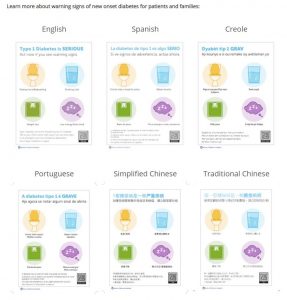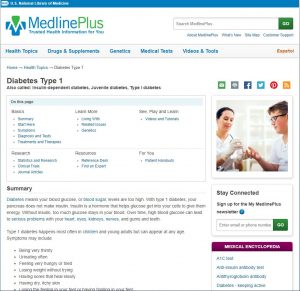Apr
01

Posted by Susan Halpin on April 1st, 2021
Posted in: Blog, NLM Resources, Patient Engagement, Public Health
Tags: type 1 diabetes

I met Dr. Erinn Rhodes last spring when she asked if she could interview me as part of her research for a paper that she was writing on Health Literacy for a class she was enrolled in. I was impressed that a pediatric endocrinologist who oversees the quality improvement program for the Endocrine Division at Boston Children’s Hospital was enrolled in the MLIS program at Simmons University because she wanted to know how to improve health literacy in order to provide the best care possible for her patients.
A few months ago, Dr. Rhodes reached out to her library network again for some help with how to disseminate important information that her Diabetes Program has created to get the word out about the warning signs for Type 1 Diabetes.
“At the start of the COVID-19 pandemic, we were seeing children presenting with diabetes in a much more severe stage of illness than what we have seen in the past. To address this, our Diabetes Program developed some simple patient posters/flyers about the warning signs of type 1 diabetes and have had them translated into a number of languages. We are continuing to strategize on ways to disseminate these tools and I was wondering if you might have thoughts on how we might share these materials with the Massachusetts library community and, of course, more broadly if possible. Please let me know if you have any ideas.”
Using MedlinePlus and the NNLM NER to Disseminate Important Information
Those of us on this email discussion contributed two ideas:
What is diabetes? What is the difference between Type 1 and Type 2 diabetes? MedlinePlus Offers a Summary and the Opportunity to Explore More Specific Information
 For those of you not familiar with the facts about diabetes, MedlinePlus offers a helpful summary for health conditions that starts with the basics and provides the opportunity for you to explore more in-depth information if you need it. https://medlineplus.gov/
For those of you not familiar with the facts about diabetes, MedlinePlus offers a helpful summary for health conditions that starts with the basics and provides the opportunity for you to explore more in-depth information if you need it. https://medlineplus.gov/
Diabetes is a disease in which your blood glucose, or blood sugar, levels are too high. Glucose comes from the foods you eat. Insulin is a hormone that helps the glucose get into your cells to give them energy. With type 1 diabetes, your body does not make insulin. With type 2 diabetes, the more common type, your body does not make or use insulin well. Without enough insulin, the glucose stays in your blood. You can also have prediabetes. This means that your blood sugar is higher than normal but not high enough to be called diabetes. Having prediabetes puts you at a higher risk of getting type 2 diabetes.
Over time, having too much glucose in your blood can cause serious problems. It can damage your eyes, kidneys, and nerves. Diabetes can also cause heart disease, stroke and even the need to remove a limb. Pregnant women can also get diabetes, called gestational diabetes.
Resources from the Diabetes Program at Boston Children’s Hospital
Did you know that type 1 diabetes is one of the most common chronic diseases in children? About one in every four hundred children in the United States develops type 1 diabetes.
People at any age, from toddlers to adults, can be diagnosed with type 1 diabetes. However, most children with type 1 diabetes are diagnosed between the ages of 4 to 6 or during puberty, between the ages of 10 and 14.
Using the resources developed by the Diabetes Program at Boston Children’s Hospital, you can learn about the causes, symptoms and the long-term impact of type 1 diabetes. The resources include a website and printable posters that are PDF files. The posters convey the important information about the warning signs of type 1 diabetes through visual pictures and words. In the hopes of reaching as many people as possible, the posters are available in several different languages in addition to English. The languages are Spanish, Creole, Portuguese, Simplified Chinese and Traditional Chinese.
What’s it like for a Child with Type 1 Diabetes?
 It’s one thing to learn about the facts of a disease. It’s another to have a face, a name, and the real-life experience of a child with type 1 diabetes. I found it very insightful to read Justin’s Story as part of these resources. Justin is a nine-year old Cub Scout who lives in Massachusetts. Justin shares in his own words, his journey from diagnosis to living with type 1 diabetes, including his fears, worries, medical care and his support systems. Justin’s Story could be a very helpful and reassuring resource for any child newly diagnosed with juvenile diabetes.
It’s one thing to learn about the facts of a disease. It’s another to have a face, a name, and the real-life experience of a child with type 1 diabetes. I found it very insightful to read Justin’s Story as part of these resources. Justin is a nine-year old Cub Scout who lives in Massachusetts. Justin shares in his own words, his journey from diagnosis to living with type 1 diabetes, including his fears, worries, medical care and his support systems. Justin’s Story could be a very helpful and reassuring resource for any child newly diagnosed with juvenile diabetes.
If you have any questions about the information in this article you can email Dr. Erinn Rhodes, MD, MPH. She is the Director of Endocrinology Healthcare Research, Quality and Safety at Boston Children’s Hospital. She is also an Assistant Professor of Pediatrics at Harvard Medical School.
On a personal note. This is my last blog post as an education and outreach coordinator for the NER. I am retiring from this position on April 2. Thank you network members and NNLM staff for making these past 4 years such a memorable and pleasant experience. I am very grateful to have had the chance to represent the NNLM and be part of an organization that helps to keep our country healthy! I will miss you. I hope our paths cross again.